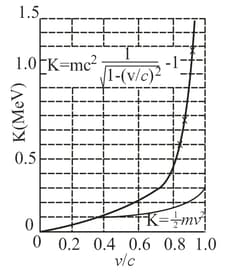The existence of the atomic nucleus was discovered in Rutherford, who properly interpreted some experiments in which a beam of alpha particles was scattered from a metal foil of atoms such as gold. If the alpha particles had a kinetic energy of what was their de Broglie wavelength? Explain whether the wave nature of the incident alpha particles should have been taken into account in interpreting these experiments. The mass of an alpha particles is (unified atomic mass units) and its distance of closest approach to the nuclear center in this experiment was about (The wave nature of matter was not postulated until more than a decade after these crucial experiments was first performed.)

Important Questions on Photons and Matter Waves
Figure shows a case in which the momentum component of a particle is fixed, so that, then, from Heisenberg's uncertainty principle, the position of the particle is completely unknown. From the same principle, it follows that the opposite is also true, that is, if the position of a particle is exactly known the uncertainty in its momentum is infinite.
Consider an intermediate case. In which the position of a particle is measured, not to infinite precision, but to within a distance of where is the particle's de Broglie wavelength. Show that the uncertainty in the (simultaneously measured) momentum component is then equal to the component itself; that is, Under these circumstances, would a measured momentum of zero surprises you? What about a measured momentum of Of Of

The function displayed in Eq. can describe a free particle for which the potential energy is in Schrodinger's equation (Eq. ). Assume now that a constant in that equation. Show that Eq. is a solution of Schrodinger's equation with
giving the angular wave number of the particle.
